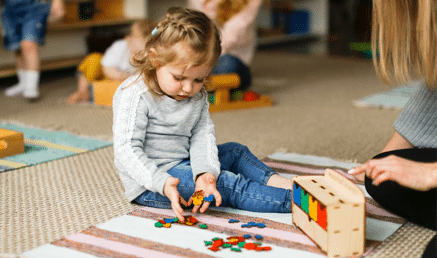
“It’s our polite nudge in the ribs to help you and your team stay organised and on task.”
This week’s subject is Child directed learning.
Element 1.2.3: Each child’s agency is promoted, enabling them to make choices and decisions that influence events and their world.
Child directed learning is about empowering children to take an active role in their learning journey. It involves creating opportunities for children to make choices, initiate activities, and lead their play or projects, which helps them develop critical skills such as problem-solving, resilience, and autonomy. This approach recognises children as competent and capable learners who can shape their experiences when provided with supportive environments and intentional teaching strategies.
Are educators consistently intentional in their pedagogical practice to ensure child-directed learning is embedded in all aspects of the educational program and routines?
Child directed learning is a crucial pedagogical practice that values, respects and nurtures the individuality of each child. When implemented effectively, child directed learning is highly beneficial to children’s learning and overall development. Children develop a strong sense of identity as they recognise their ability to influence their world. They build resilience by navigating challenges and making decisions, which enhances their confidence and problem-solving skills. Additionally, this approach fosters a sense of belonging, as children feel valued and respected within their learning environment. For school-age children, these experiences complement their school and home life, nurturing essential life skills like negotiation, leadership, and collaboration.
Practical strategies for facilitating child directed learning:
-
- Set up the environment with children’s individual interests in mind. Include a variety of materials and resources that spark interest, are open ended and stimulating.
- Educators should arrange indoor and outdoor spaces to offer a range of choices, allowing children to decide what activities to engage in and how to approach them, e.g a range of open-ended resources like blocks, loose parts, craft supplies, or natural elements encourages children to explore and create according to their interests.
- Implementation of flexible routines, such as allowing children to choose when to eat or rest, further promote autonomy.
- Request children’s input when planning the set-up of the physical environment.
- Allow opportunities for exploration of the natural environment, both indoors and outdoors.
- Use your knowledge of children’s interests to create situations and experiences that inspire children’s play, exploration and learning.
- Respond to children’s ideas and suggestions and provide them with the space and resources to extend on their play and learning through follow up experiences or long-term projects.
- Allow the program and routines to be flexible, allowing children to direct their play and learning experiences away from planned experiences, when required.
- Provide extended periods of uninterrupted time and space for child initiated and child directed play.
- Support, stimulate and scaffold children’s emerging skills.
- Identify and respond to children’s individual needs & interests and provide additional support and resources, where required.
- Educators are intentional and utilize opportunities to scaffold learning by the use of open-ended questioning to extend discussions, spark curiosity and encourage children to think critically about their choices.
- Educators encourage children to take calculated risks and solve problems independently. Educators support this by creating safe environments where children feel confident to explore, experiment and face new challenges.
- Involve children in planning activities or setting up the environment. For instance, a child might decide the theme for a group project or lead an activity. Acknowledging children as capable leaders by encouraging them to guide younger peers or make decisions about group play fosters a sense of responsibility and confidence.
Consider the following at your next team/reflection meeting to explore how child-directed learning is embedded in practice at your Service:
-
- How are our indoor and outdoor spaces arranged to provide children with genuine choices?
- Are the materials and resources open-ended and sufficient to support diverse play-based learning experiences?
- Are educators responsive to children’s ideas, incorporating them into the program?
- How often do educators use open-ended questions to encourage children to scaffold and lead their learning?
- Do educators foster inclusion by ensuring all children, including those with additional and diverse needs, are given opportunities to make choices and influence their environment?
- What adjustments can we make to ensure every child’s agency is supported?
- How do we document children’s decision-making and leadership in their learning?
- Are we reflecting on these observations to inform future planning?
- How do we engage with families and collect information to better understand their child’s interests, background and abilities to better support child-directed learning?
- How do educators balance intentional teaching with allowing children to lead their own learning? Are there moments where educators could step back to give children more control?
- How are educator’s pedagogical practices fostering a sense of belonging and confidence in children?
- Are children showing increased resilience and persistence in their decision-making because of educator’s intentional strategies?
Resources:
Supporting Agency: Involving Children in Decision-Making
Early childhood learning trajectories user guide for educators, teachers and service leaders
Guide to the NQF- Child directed learning
Children’s sense of agency fostered through self-directed play, inspiring rich learning
We Hear You blog- The powerful citizens of OSHC
Within System7 go to Quality Area 1/Module 6 to submit self-assessment notes and if required, open a QIP issue if you identify any areas of improvement.
The Childcare Centre Desktop has a range of resources to assist services with educational program and practice and child directed learning. These include Educational Program Policy, Assessment and Planning Cycle Guide and Procedure, All About Me- Child Introduction Form, Critical Reflection Template, Observation Record, Educational Program and Practice Procedure, Program Template and much more.
Resources, NQS Element, Regulation and System7 links:
Childcare Centre Desktop – Childcare Centre Desktop
National Quality Standard – QA 1/ 1.2.3- Child directed learning
National Regulations – 73, 74, 155, 156
System7 Module – QA 1/ Module 6
If you have any questions send us a note via the Contact page here!




